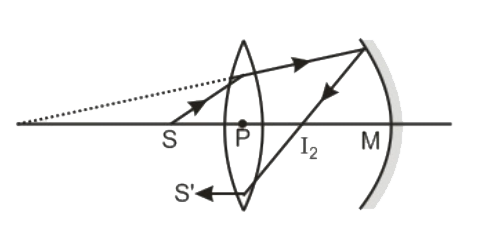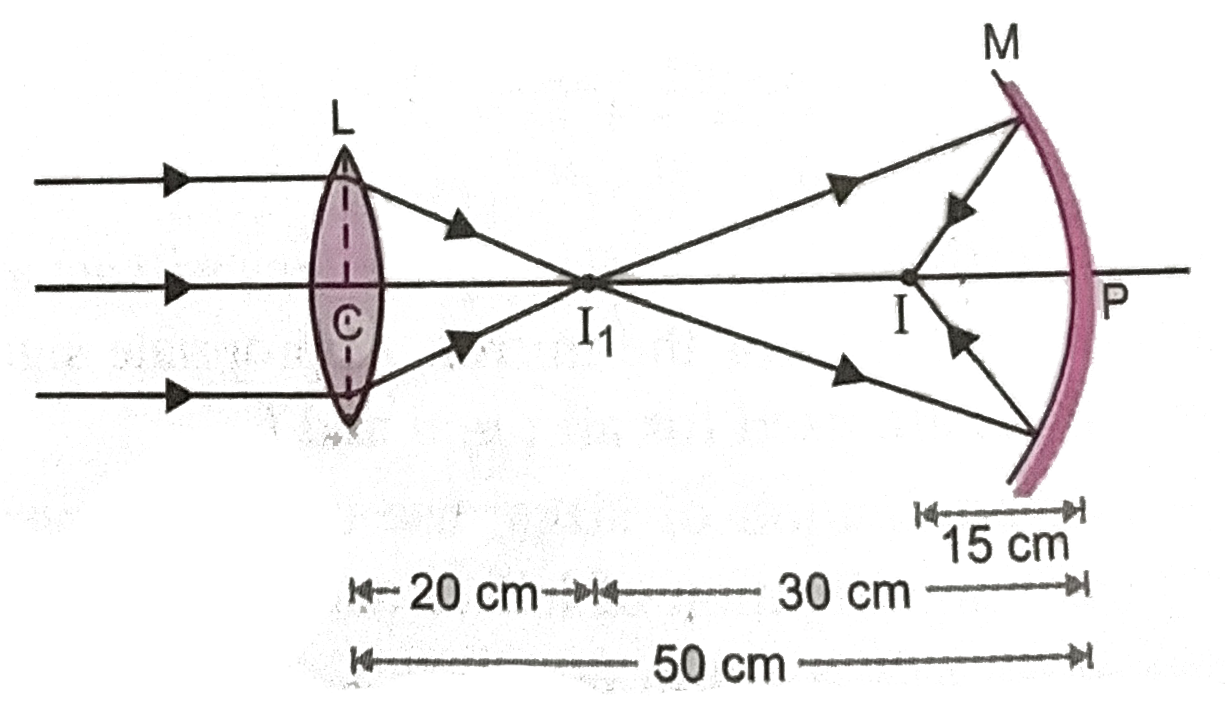A converging lens of focal length 15 cm and a converging mirror of focal length 10 cm are placed 50 cm apart with common principal axis. A point source is placed in between the lens and the mirror at a distance of 40 cm from the lens. Find the locations of the two images formed.
The correct Answer is:A, B, C, D
The object is placed in the focus of the converging mirror
There will be two images
a. one due to direct transmission of light through lens.
b. One due to reflection& then transmission of the rays through lens.
Case I (S') For the image by direct transmission u=−40cm,f=15cm<br>rarr 1/v-1/u=1/f<br>rarr 1/v=1/15+1/(-40)=(40-15)/(40xx15)<br>rarr v=(40xx15)/(40-15)<br>=24cm. (left of lens)
Case II:(S') Since the object is placed on the focus of mirror, after reflectionn the rays become parallel for the lens.
So, u=0→f=15cm
→1v−1u=115
→v=15cm(≤ftof≤ns)
Topper's Solved these Questions
Similar Questions
A converging lens of focal length 20 cm and a converging mirror of focal length 10 cm are placed 60 cm apart with common principal axis. A point source is placed in between the lens and the mirror at a distance of 50 cm from the lens. Find the locations of the images formed.
View SolutionA converging lens of focal length 15 cm and a converging mirror of focal length 20 cm are placed with their principal axes coinciding. A point source S is placed on the principal axis at a distance of 12 cm from the lens, as shown in figure. It is found that the final beam comes out parallel to the principal axis. Let the separation between the mirror and the lens be 10×k. Find k.
 View Solution
View Solution
Knowledge Check
- Question 1 - Select One or More
A convex lens of focal length 20 cm is placed in front of a convex mirror of focal length 15 cm at a distance of 5 cm. An object of length 2 cm is placed perpendicular to the common axis at a distance of 20 cm from the lens
AThe final image is formed at 163 cm from the lensBThe final image is formed at infinityCThe size of final image is 10.7 cmDThe size of final image is very large
A converging lens of focal length 12 cm and a diverging mirror of focal length 7.5 cm are placed 5.0 cm apart with their principal axes coinciding. Where should an object be placed so that its image falls on itself ?
View SolutionA converging lens of focal length 15 cm and a converging mirror of focal length 10 cm are placed 50 cm apart. If a pin of length 2.0 cm is placed 30 cm from the lens farther away from the mirror, where will the final image form and what will be the size of the final image ?
View SolutionA diverging lens of focal length 20 cm and a converging lens of focal length 30 cm are placed 15 cm apart with their principal axes coinciding. Where should an object be placed on the principal axis so that its image formed at infinity ?
View SolutionA diverging lens of focal length 12 cm and a converging mirror of focal length 10 cm are placed coaxially at a separation of 5 cm. Where should an object be placed so that a real image is formed at the object itself ?
View SolutionA convex lens of focal length 20cm and a convex mirror of focal length 10cm are placed co-axially 50cm apart from each other. An incident beam parallel to its principal axis is incideent on the convex lens. Locate the position of final image formed due to the combination.
View SolutionA converging lens has a focal length of 50cm. The power of this lens is :
View SolutionA convex lens of focal length 20cm and a convex mirror of focal length 10cm are placed co-axially 50cm apart from each other. An incident on the convex lens. Locate the position of final image formed due to the combination.
 (NCERT Solved Example)View Solution
(NCERT Solved Example)View Solution

